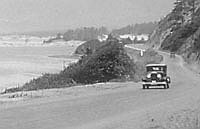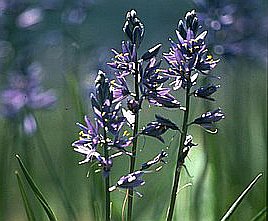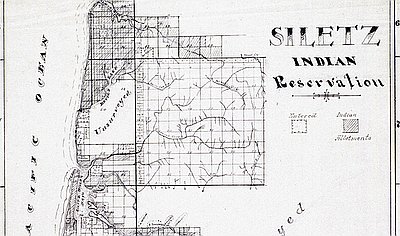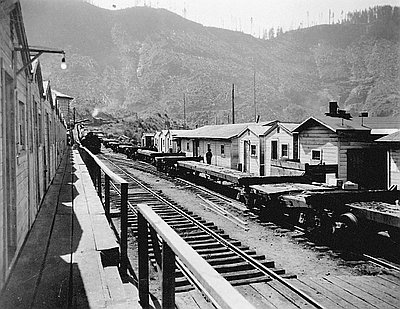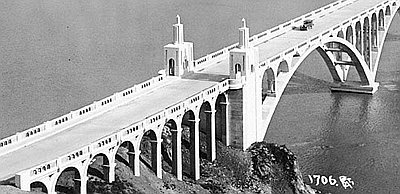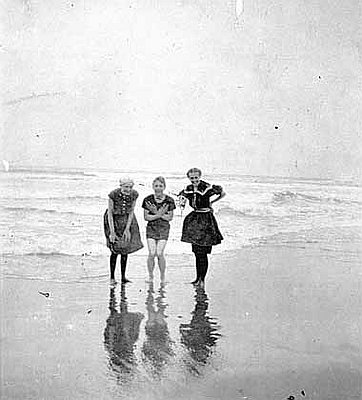Treaties and Reservations
By the early 1850s, Euro-Americans were moving into the Oregon Territory in ever-greater numbers. Even though Congress had acknowledged Indian title to their lands in the 1848 Organic Act, which had established the territory, the flood of newcomers effectively pushed many people off their lands before title had been legally obtained.
In 1851, the federal government negotiated treaties with nineteen tribes and bands in western Oregon and southwestern Washington, including the Chinook on the Columbia River, the Tillamook on the northern coast, and the Rogue River near Port Orford. The tribes signed each in good faith, but Congress ratified none of them. As a result, none of the land on the coast that was taken from Indians and opened to settlement was legally obtained by ratified treaty.
Congress did ratify treaties negotiated between 1853 and 1855 with the Rogue, Siuslaw, Lower Umpqua, Coos, Coquille, Takelma, Shasta, Kalapuya, Tualatin, and Molala. Those treaties did not include traditional rights, such as hunting and fishing in accustomed places. They reserved for the tribes only small remnants of their traditional homelands and provided for payment of only a few pennies per acre for the land that was taken—and that in the form of annuities paid out over twenty years. None of the tribes wanted to confederate, having built societies and governance around their own village systems and languages. The treaties were probably negotiated in Chinook Jargon by John Flett, who had immigrated to the Oregon Country in 1841 from the Selkirk Settlement in the Red River Valley and was employed by the United States as an interpreter. Although Chinook Jargon facilitated the treaty negotiations, its limited vocabulary made a nuanced conversation difficult.
Indian-white relations were especially tense in southern and southwestern Oregon, where strikes of gold were attracting miners to the area. After the Battle Rock skirmish at Port Orford in 1851, in which nine would-be settlers killed twenty Indians and then fled up the coast, federal troops were stationed at the new Fort Orford to protect white settlers while Indian agents tried to negotiate treaties and keep the peace.
Violence broke out sporadically, mostly perpetrated by whites against Indians. Miners and settlers organized themselves into militias or, more accurately, vigilante mobs that were barely contained by U.S. Army troops. These irregulars committed atrocities such as sacking noncombatant villages; killing old men, women, and children; and burning houses to the ground.
In February 1856, Rogue Indian raiders swept through the pioneer settlements, killing twenty-three people. Violence continued until May, when two Rogue leaders representing the main body of the warriors agreed to gather their people at Big Bend, at the confluence of the Illinois and the Rogue Rivers.
As the people arrived at Big Bend on foot and in canoes, prepared to surrender, the volunteers attacked again. The Rogue warriors fought back, but in two days they were beaten. The once-populous tribes of southern Oregon had been reduced by repeated epidemics of European diseases and worn down by war, flight, hunger, and uncertainty. In June 1856, near Port Orford, the last group surrendered—thirty-five men, ninety women, and ninety children.
The following year the defeated Rogues were transported to the Coast Reservation, which had been established in 1855. The Rogues who surrendered at Big Bend were transported on the steamer Columbia, which took them north from Port Orford. Those who surrendered at Port Orford were forced to walk the 125 miles up the coast. The reservation was described by a visiting army officer: “abounds in game of various kinds, is well watered...contains sufficient arable land...is heavily timbered and rich in nuts, roots, and other articles of food as these Indians have always been accustomed to.” Most important, he reported, the land “has not yet been considered as worth occupying by the whites.” That, as we shall see, would change.
© Gail Wells, 2006. Updated and revised by OHP staff, 2014.
